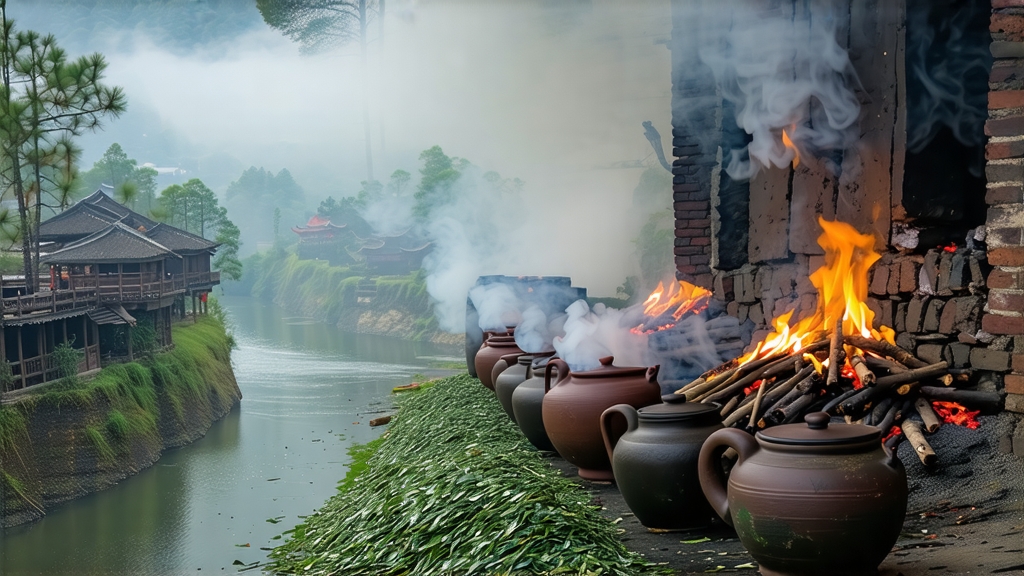
Ask most Western drinkers to name a Chinese black tea and they will murmur “Earl Grey” or “English Breakfast,” unaware that both blends were originally built around a single leaf born in the granite gorges of northern Fujian. That leaf is Lapsang Souchong—Chinese spelling Zheng Shan Xiao Zhong—the earliest documented black tea in history and the prototype that launched the global craving for fully oxidized leaves. This article invites you to travel from the mist-wrapped Wuyi massif to your own teapot, tracing the cultivar, the smoke, the craft, and the cup that once intoxicated London merchants and still seduces modern palates.
-
Terroir and cultivar
The protected geographical indication “Zheng Shan” can legally be applied only to leaves picked within a 600–1 200 m belt inside the Wuyi National Nature Reserve, where a subtropical monsoon climate collides with mineral-rich granite soils. The area records 80 % relative humidity year-round; drifting clouds act like a natural shade cloth, slowing photosynthesis and concentrating amino acids. Two indigenous cultivars dominate—Xiao Ye Zhong (small leaf) and the slightly larger Wu Ye Zhong—both descendants of Camellia sinensis var. sinensis adapted to cool, foggy mornings. Their petite leaves carry more monoterpenes than lowland bushes, the very molecules that later bond with pine smoke to create Lapsang’s signature aroma. -
Historical snapshot
The smoking accident is said to have happened in 1646 when Qing troops marched through Tongmu village, forcing tea farmers to rush their drying crop. In desperation the villagers spread fresh leaves over pine fires so they could flee before the soldiers arrived. The Dutch traders who received that year’s “bohea” (the Amoy dialect pronunciation of “Wuyi”) found the smoky character exotic; by 1669 the East India Company listed “Souchon” at 28 silver taels per picul, ten times the price of green tea. Thus Lapsang Souchong became the first Chinese black tea exported to Europe, establishing the very category the British later called “black.” -
Harvest calendar
Authentic Zheng Shan is picked only in spring, between Qingming and Grain Rain, when two leaves and a bud measure 2.5–3 cm and still hold the downy silver tip that connoisseurs call “white eyebrow.” A second, lesser flush in late autumn is sometimes processed, but summer and winter plucking is forbidden under the GI code to protect plant vigor. Roughly 3.5 kg of fresh shoots yield 1 kg of finished tea, yet only 50 000 kg of true Tongmu Lapsang reach the market each year—less than one day’s output from a single large Ceylon estate. -
Craft: withering over pine embers
Unlike orthodox black teas that wither on bamboo racks, Lapsang is laid on screens suspended 60 cm above stone troughs filled with embers of Masson pine and Chinese red pine. The temperature is kept at 28–30 °C for the first two hours, then raised to 38 °C for a final hour, during which the leaves lose 60 % moisture and absorb α-pinene and bornyl acetate from the resinous smoke. Master smokers gauge readiness by touch: a leaf must snap, not fold, yet still feel leathery rather than brittle. This step, called “song xun,” is the soul of Lapsang; too little smoke and the tea tastes hollow, too much and it becomes medicinal. -
Rolling, oxidation, and firing
While still warm, the withered leaves are rolled for 45 minutes in a cast-iron cylinder rotating at 28 rpm. Cell walls rupture, polyphenols meet polyphenol oxidase, and the leaves darken from jade to copper within 20 minutes. Oxidation proceeds on woven bamboo trays inside a pine-wood closet at 24 °C and 75 % humidity; every 15 minutes a craftsman lifts a handful to sniff for the transition from grassy to dried-longan sweetness. When the aroma peaks—usually after 90 minutes—the leaves are pan-fired at 200 °C for two minutes to lock in the smoky-sweet balance, then cooled rapidly on marble slabs. -
The two faces of Lapsang
Traditional “Smoke